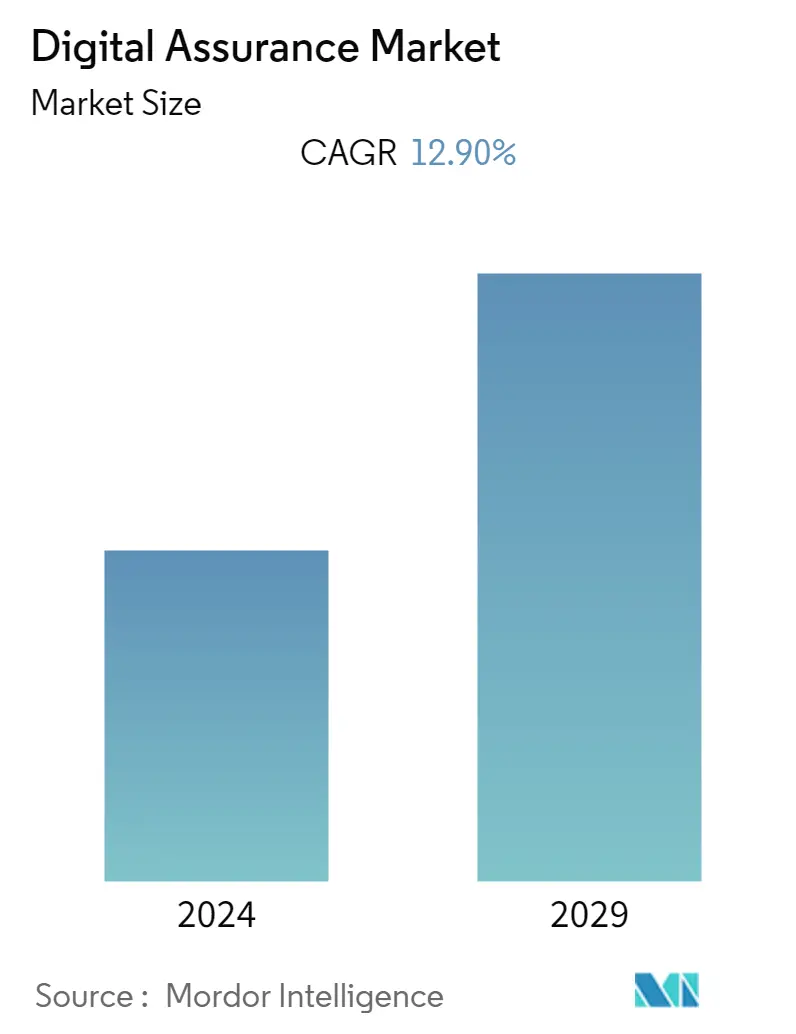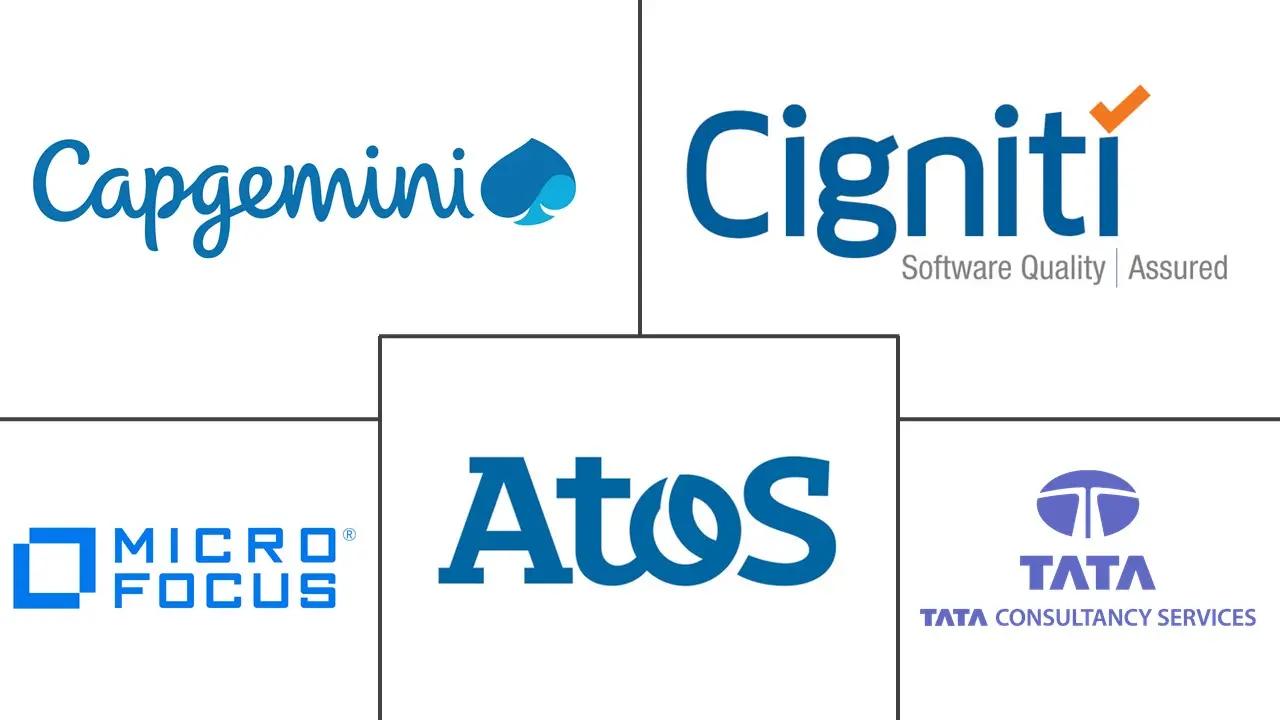Market Size of Digital Assurance Industry

| Study Period | 2019 - 2029 |
| Base Year For Estimation | 2023 |
| CAGR | 12.90 % |
| Fastest Growing Market | Asia Pacific |
| Largest Market | North America |
| Market Concentration | Medium |
Major Players
*Disclaimer: Major Players sorted in no particular order |
Digital Assurance Market Analysis
Digital Assurance Market is registering a CAGR of 12.9% during the forecast period. The digital economy is transforming the way business runs, owing to the significant shift in the quality assurance service and competitive rivalry. Modern businesses are opting for reliability and digital assurance to leverage the market demand. In order to enhance performance while ensuring the customer experience, the market demands digital assurance.
- Digital assurance is not confined to testing applications across social, mobile, analytics & cloud (SMAC), IoT, and big data, among others. It also ensures that the desired business outcomes are achieved as a result of the digital transformation initiatives adopted. For instance, digital assurance solutions go beyond the functional validations required for applications such as SMAC and perform various aspects such as network capability, optimal performance, interoperability, and enhanced security. This instance enables the business to adopt digital assurance over traditional Quality Assurance (QA) testing.
- In the current market scenario, organizations must focus more on creating consistent and seamless experiences apart from meeting the customer's demands for products and services. By leveraging digital assurance omnichannel capabilities, organizations can deliver automated solutions that offer better accessibility, seamless experience, and lesser wait time.
- Due to the increasing demand for digitalization, it is used in nearly every enterprise. For businesses going through a digital transition, digital assurance is a technique for ensuring smooth interactions between various parts of the digital ecosystem and networks. The World Economic Forum estimates that by 2025, digital transformation will have increased the global economy by USD 100 trillion. The market for digital assurance is therefore driven by IT businesses' expanding digital transformation projects.
- The open-source and as-a-service solutions are broadly available and straightforward to use. Still, it can be difficult to exchange and connect data across many repositories, resulting in a lack of quality transparency at the business level, negatively impacting the trust of the overall Digital Assurance market and becoming a challenge for market growth.
- Additionally, COVID-19 has brought about a reactive yet deliberate transformation of enterprises' digital presence and support to the customers. Also, the economic scenarios have increased the pressure on the business to ensure a memorable online experience. Creating and disseminating digital content has increased significantly due to the growing push for digital engagement. According to a study of 1,600 marketing and creative professionals by Bynder in 2021, the digital transformation initiatives have gained traction during the pandemic, and owing to this, generating more digital content and creative output, implementing new digital experience technologies, and investing in customer data and analytics are the focal points of marketing departments. This is expected to have a positive impact on the market.
Digital Assurance Industry Segmentation
Digital assurance refers to solutions that ensure the digital transformation projects attain the objectives led by the businesses. The assurance of the quality of digital transformation projects involves a testing host of technological paradigms such as mobility, and cloud, among others. The use of digital assurance across the end-users (government, healthcare, industrial, BFSI, manufacturing, IT and telecommunications, among other verticals) is analyzed in various geographies. The report also covers the analysis of the impact of COVID-19 on the market and the stakeholders, and the same has been considered for the current market estimation and future projections.
| By Testing Type | |
| Functional Testing Solution | |
| Performance & Usability Testing | |
| Security Testing | |
| API Testing | |
| Network Testing |
| Testing Mode | |
| Manual Testing Deployment | |
| Test Automation Deployment |
| End-user Verticals | |
| Government | |
| BFSI | |
| Healthcare | |
| Manufacturing | |
| IT & Telecommunication | |
| Media & Entertainment | |
| Others End-Users |
| Geography | |
| North America | |
| Europe | |
| Asia Pacific | |
| Latin America | |
| Middle East & Africa |
Digital Assurance Market Size Summary
The digital assurance market is experiencing significant growth, driven by the rapid transformation of the digital economy and the increasing demand for reliable and efficient quality assurance services. Modern businesses are increasingly adopting digital assurance to enhance performance and customer experience, moving beyond traditional quality assurance methods. This shift is facilitated by the need to achieve desired business outcomes through digital transformation initiatives, which include ensuring optimal performance, interoperability, and enhanced security across various digital platforms. The market is further propelled by the growing emphasis on creating seamless and consistent customer experiences, leveraging omnichannel capabilities to deliver automated solutions that improve accessibility and reduce wait times.
The Asia Pacific region is poised for substantial growth in the digital assurance market, fueled by the region's push towards digital transformation and the increasing adoption of cloud networks and edge computing. Countries like China, India, and Japan are developing niche markets within specific ICT segments, supported by government initiatives and investments from technological vendors. The COVID-19 pandemic has accelerated this transformation, highlighting the need for businesses to prioritize digital assurance to maintain competitive advantage. The market is moderately consolidated, with key players focusing on new product development, strategic partnerships, and investments to enhance their offerings and maintain their market position.
Digital Assurance Market Size - Table of Contents
-
1. MARKET INSIGHTS
-
1.1 Market Overview
-
1.2 Industry Attractiveness- Porter's Five Forces Analysis
-
1.2.1 Threat of New Entrants
-
1.2.2 Bargaining Power of Consumers
-
1.2.3 Bargaining Power of Suppliers
-
1.2.4 Threat of Substitutes
-
1.2.5 Intensity of Competitive Rivalry
-
-
1.3 Assessment of COVID-19 Impact on the Industry
-
-
2. MARKET SEGMENTATION
-
2.1 By Testing Type
-
2.1.1 Functional Testing Solution
-
2.1.2 Performance & Usability Testing
-
2.1.3 Security Testing
-
2.1.4 API Testing
-
2.1.5 Network Testing
-
-
2.2 Testing Mode
-
2.2.1 Manual Testing Deployment
-
2.2.2 Test Automation Deployment
-
-
2.3 End-user Verticals
-
2.3.1 Government
-
2.3.2 BFSI
-
2.3.3 Healthcare
-
2.3.4 Manufacturing
-
2.3.5 IT & Telecommunication
-
2.3.6 Media & Entertainment
-
2.3.7 Others End-Users
-
-
2.4 Geography
-
2.4.1 North America
-
2.4.2 Europe
-
2.4.3 Asia Pacific
-
2.4.4 Latin America
-
2.4.5 Middle East & Africa
-
-
Digital Assurance Market Size FAQs
What is the current Digital Assurance Market size?
The Digital Assurance Market is projected to register a CAGR of 12.90% during the forecast period (2024-2029)
Who are the key players in Digital Assurance Market?
Capgemini SE, Micro Focus, TATA Consultancy Services Limited, Cigniti Technologies and Atos are the major companies operating in the Digital Assurance Market.

